| History of a kite which becomes a plane by the Wright Brothers |
| Kite History | to glider at the first fly | Kitty Hawk today | Home wokipi-kite | ||||||
|
|||||||||
1900
- Glider trials at Kitty Hawk. It was one thing to design a small kite, quite another to build a large glider and launch into the air. The Wrights next began to study aerodynamics and structures in preparation for building their first piloted glider. It was one thing to design a set of wings for a small kite, quite another to build a large, heavy glider, climb aboard, and launch oneself into the air. The brothers now began to consider such things as the precise curve of the wing profile, the wing area necessary to lift a pilot, and the type of materials needed to construct a glider. 1901 - The Biggest glider yet. Larger than it's predecessor, the 1901 glider suffered from a lack of lift and control problems. The poor lift performance of their 1900 glider made the Wright brothers question, but not abandon, the aerodynamic data and equations they had relied upon. To increase lift on their next glider, they simply increased the size of the wings and the curvature of the airfoil. They returned to Kitty Hawk in 1901 to test the new glider. |
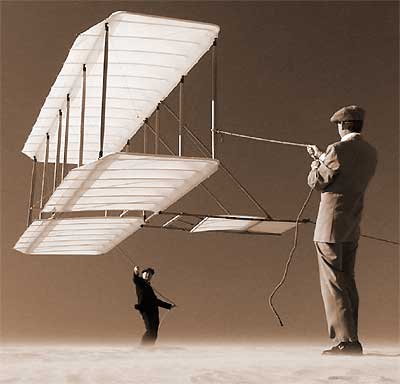 |
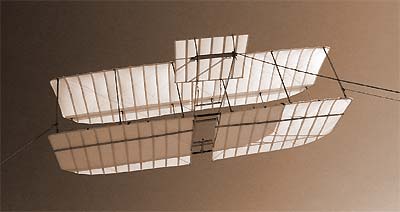 |
The results were discouraging. Although more and longer free glides
were made than in the previous year, the new glider performed
worse than the 1900 craft. It still suffered from lack of lift
and now had control problems as well. 1902 - Close to a true airplane. The 1902 glider performed dramatically better than its predecesors. By December 1901, the Wright brothers had accumulated all the aerodynamic data they needed to build a successful flying machine. However, they did not immediately try to build a powered airplane. They could not be sure that data obtained from tiny model wings would translate to a full-size aircraft. |
And they still had to solve the mysterious control problems that
surfaced during the 1901 glider trials. Rather than risk life and limb on a large, heavy, untried powered flying machine, Wilbur and Orville decided to build one more glider. 1903 - The first successful airplane. 1903 marks the year that the Wright brothers invented the first successful airplane. Buoyant over the success of their 1902 glider, the Wright brothers were no longer content to merely add to the growing body of aeronautical knowledge; they were going to invent the airplane. Still, they recognized that much hard work lay ahead, especially the creation of a propulsion system. During the spring and summer of 1903, they were consumed with leaping that final hurdle into history. On December 17, 1903, Wilbur and Orville Wright made four brief flights at Kitty Hawk with their first powered aircraft. The Wright brothers had invented the first successful airplane. 1904 - The first circular flight. While the Wrights had achieved powered flight, they had not yet created a practical airplane. |
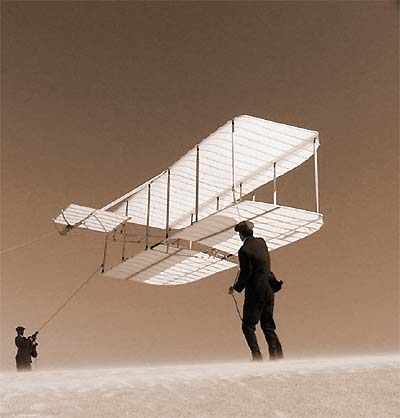 |
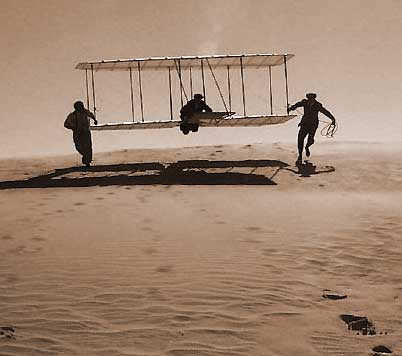 |
On January 5, 1904, the Wright brothers made a statement to the
Associated Press regarding their Kitty Hawk flights. They gave
an account of the events, and then in closing affirmed that they
had achieved their goal: "We packed our goods and returned
home, knowing that the age of the flying machine had come at last." However, the 1903 Flyer had only performed short, straight-line flights. To successfully market their invention, they had to demonstrate that it could turn and fly over more commonplace terrain than the sandy open spaces of Kitty Hawk. With this goal in mind, Wilbur and Orville refined their design with two more powered aircraft in 1904 and 1905. 1905 - The first practical airplane. By the fall of 1905, the Wright brothers' experimental period ended. With their third powered airplane, they now routinely made flights of several minutes. On October 5, Wilbur made a spectacular flight in which he circled the field 30 times in 39 minutes for a total distance of 24 1/2 miles. In every sense, the Wrights now had a practical airplane. They turned their attention to securing their patent and seeking a customer for their invention. The Wright Model A was the aircraft that convinced the world that the Wrights had indeed flown. It was also the first two-seat aircraft, and the first Wright aircraft in which the occupants sat upright. |
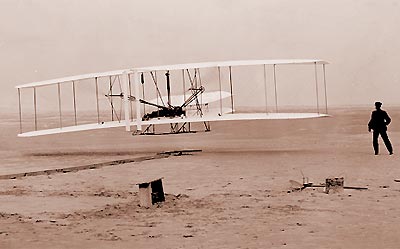 |
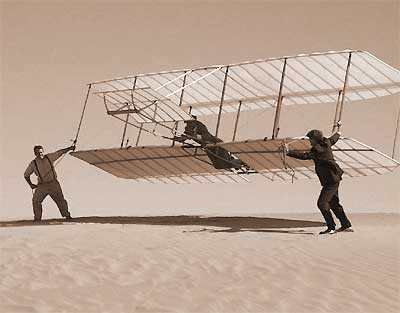 |
||
Then, in 1909 the Military Flyer, slightly
smaller and faster that the Model A. The Wrights sold this aircraft
to the United States Army Signal Corp to become the first military
aircraft. |
|||
| The 1905 Wright Flyer was restored in the late 1940's with the help of Orville Wright and now is on display at Carillon Historical Park, Dayton. (www.carillonpark.org). The 1904 Flyer does not survive. |
| photo credit of this page : Wokipi and www.wright-brothers.org |